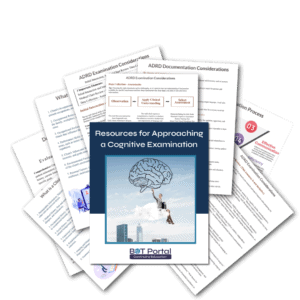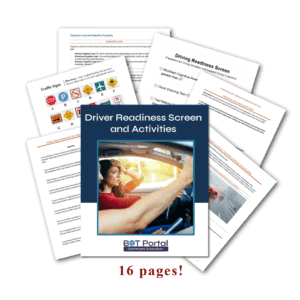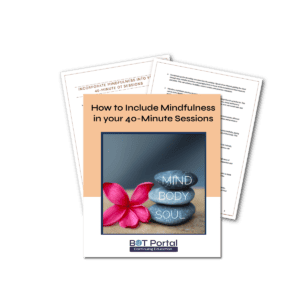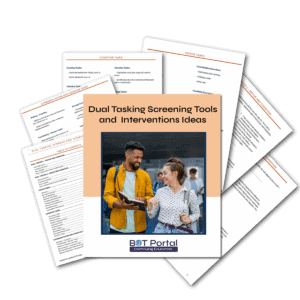
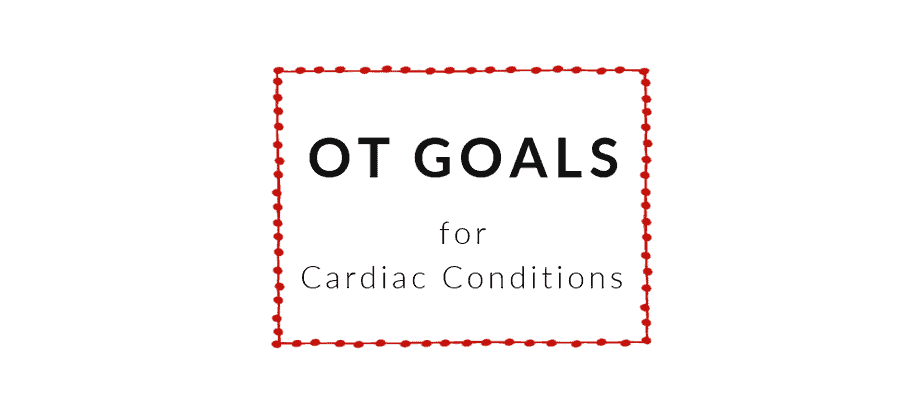
OT Goals for Cardiac Conditions
Simple Goals for Cardiac Conditions
The patient will demonstrate improved activity tolerance for occupational completion as evidenced by the completion of [xx] of sustained light activity with a perceived BORG scale assignment of no greater than 3/10 within [xx] weeks.
The patient will demonstrate the learning and incorporation of diaphragmatic and pursed-lip breathing strategies as evidenced by self-initiated advocacy and execution of strategies during 3 consecutive sessions over [xx] weeks in order to improve carryover into daily activities.
The patient [or caregiver] demonstrates utilization and/or understanding of energy conservation techniques and pacing as evidenced by self-initiated advocacy and execution of strategies during 3 consecutive sessions over [xx] weeks in order to improve carryover into daily activities.
The patient will demonstrate decreased manifestations of dyspnea during activity performance as evidenced by [xx] consecutive sessions throughout the plan of care when patient demonstrates self-initiated rest breaks, and controlled breathing strategies during activities that lapse 10+ minutes in order to ensure maximum carryover during occupation-specific tasks within the 9 domains of occupations.
The patient will demonstrate safe use of adaptive equipment [xx, xx, and xx] purposed to maintain sternal precautions as evidenced by completion of occupation-specific tasks of [dressing, bathing, functional mobility] with 100% accuracy and without the need for verbal cues during xx/xx treatments over xx weeks.
The patient will demonstrate and/or verbalize understanding of proper/safe use of oxygen and related equipment within xx sessions in order to improve safety and health management when returning home.
The patient will demonstrate/verbalize understanding of sternal/cardiac precautions as evidenced by the ability to recite all sternal precautions to therapist without error during [xx] consecutive treatments over a [xx] week plan of care.
The patient [or caregiver] will demonstrate understanding of how to decrease an exacerbation of condition and/or thrombus as evidenced by verbal declaration and discussion of at least [xx] strategies within [xx] weeks.
The patient [or caregiver] will demonstrate safe functional household mobility using a least restrictive and appropriate ambulating device as evidenced by completion of a multi-surface and multi-elevation obstacle course with an ambulation device without LOB, error, or fear of following within [xx] week plan of care.
See BOT Portal for more.

What is Occupational Therapy’s Role in Cardiac Rehabilitation?
Occupational therapy plays a crucial role in cardiac rehabilitation by helping individuals recover from cardiovascular events, such as heart attacks or heart surgeries, and regain independence in daily life activities. Here’s how occupational therapists contribute to cardiac rehabilitation:
Assessment and Evaluation: Occupational therapists conduct comprehensive assessments to evaluate the individual’s functional abilities, physical limitations, and cardiovascular risk factors. They assess the client’s strength, endurance, mobility, balance, and ability to perform activities of daily living (ADLs) such as self-care, household tasks, and work-related activities.
Activity Modification and Energy Conservation: Occupational therapists educate clients on energy conservation techniques and activity modification strategies to manage fatigue and optimize energy expenditure during daily activities. They teach pacing techniques, prioritization skills, and adaptive strategies to help individuals conserve energy and prevent overexertion, while still accomplishing meaningful tasks and responsibilities.
Exercise Prescription and Conditioning: Occupational therapists prescribe individualized exercise programs tailored to the client’s cardiovascular health, fitness level, and rehabilitation goals. They incorporate aerobic conditioning, strength training, flexibility exercises, and cardiovascular fitness activities into the client’s daily routine to improve cardiovascular function, endurance, and overall physical fitness.
Lifestyle Modification and Risk Reduction: Occupational therapists provide education and support to help individuals adopt heart-healthy lifestyle habits and reduce cardiovascular risk factors. They address modifiable risk factors such as smoking, unhealthy diet, sedentary lifestyle, stress, and poor sleep habits, and collaborate with clients to develop personalized strategies for behavior change and long-term risk reduction.
Psychosocial Support and Coping Strategies: Occupational therapists address the psychosocial impact of cardiovascular events on individuals and their families, including anxiety, depression, stress, and adjustment issues. They provide emotional support, coping strategies, and stress management techniques to help individuals navigate the emotional challenges of recovery and promote overall well-being and resilience.
Occupational Engagement and Participation: Occupational therapists focus on promoting engagement in meaningful occupations and activities that contribute to the individual’s overall health, well-being, and quality of life. They assist clients in identifying meaningful goals, interests, and roles, and work collaboratively to develop strategies for resuming valued activities and roles after a cardiovascular event.
Home and Environmental Modifications: Occupational therapists assess the client’s home environment and recommend modifications or adaptations to promote safety, accessibility, and independence. They provide guidance on assistive devices, adaptive equipment, and home modifications to support the client’s functional abilities and facilitate successful transition back to home and community living.
Collaboration and Multidisciplinary Care: Occupational therapists collaborate with other healthcare professionals, including physicians, nurses, physical therapists, dietitians, and social workers, to provide holistic and coordinated care for individuals in cardiac rehabilitation. They contribute their unique expertise in activity analysis, functional assessment, and rehabilitation principles to optimize the client’s recovery and long-term outcomes.
Browse the Resource Store!
Don’t want to pay for each PDF individually? No problem! The BOT Portal Membership comes with all printable resources and more!

